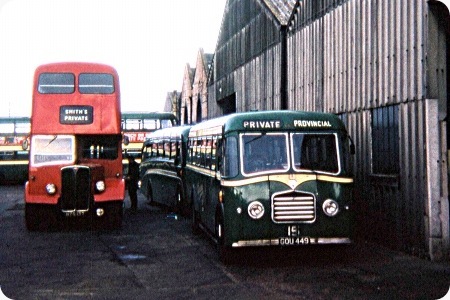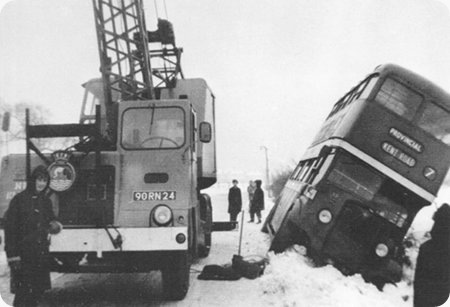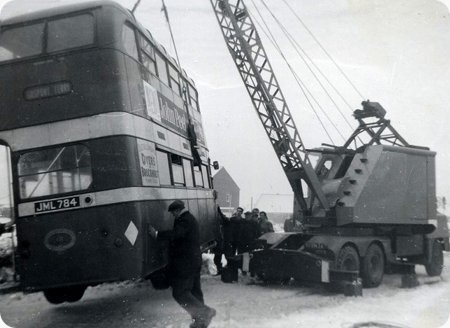Provincial – AEC Regal I/Regent I – EHO 282 – 15
Provincial (Gosport & Fareham Omnibus Co)
1943
AEC Regal I/Regent I
Reading H??/??R
Doubt exists about the vehicle chassis type, but here is the story as of now.
In 1943, Mr Orme-White carried out his first (of many) vehicle re-constructions, involving an AEC Regal I (although recent research suggests it was a Regent I chassis), purchased from the War Department with the registration DK 7791. The original source of the chassis is unknown.
Provincial re-conditioned the chassis, fitted a 7.7 litre AEC engine and got Reading’s of Portsmouth to body it. It was their first double deck offering, of utility specification and painted wartime grey. It was also re-registered EHO 282 and numbered 15.
In 1952, it was rebuilt again by Reading and lasted in service until 1959. Its body was then donated to number 12 (FHO 604) and the chassis scrapped.
What is interesting is that a small and almost unknown bodybuilder was given permission to build an austerity body and it might well have been its sole effort. The year of build was after the initial austerity bodies had been built on ‘unfrozen’ chassis, but before full-scale austerity bodybuilding had got underway. Did Reading come up with its own design or use someone else’s austerity plans? If the latter, the question is whose does it resemble?
Photograph Reading Coachworks (from the website below).
Copy contributed by Chris Hebbron using material by Ray Tull and
Stewart Brett from the website //www.regent8.co.uk/regents.htm
———
08/09/11 – 14:27
What clue is there in the fuel pump on the bulkhead?
Joe
———
08/09/11 – 14:28
Probably of no significance at all, but the next registration to the original donor vehicle, DK 7792, was a Regal supplied to Yelloway in 1932.
Stephen Ford
———
08/09/11 – 14:29
The DK registration on the chassis was a Rochdale area plate.
Roger Broughton
———
08/09/11 – 14:30
Looks like a semi-floating hub at the back, so can’t be later than 1932. And what a well-proportioned body!
Ian Thompson
———
I lived in the Gosport area as a child from 1949 to 1952, and well remember the Provincial (Gosport & Fareham) Regents. These initially puzzled me as their sound was so unlike the London Transport AECs that I recalled as a very small boy from 1946, when I lived in Selsdon, Croydon. I personally much preferred the Guy/Park Royal bodied Guy Arab IIIs that served the Alverstoke and Haslar Route 11 on which I lived, and the Arab III is still one of my favourite bus types.
It is now thought that EHO 282 was a Regent. The Regal had a longer wheelbase than the double deck chassis. The photo indicates that the proportions of the bus are in keeping with those of a Regent, whereas a double deck body on a Regal would have necessitated a short length behind the rear axle to keep within the 26ft overall length limit of the time.
Roger Cox
———
10/09/11 – 07:42
One thing I didn’t mention originally was the bespoke double destination blind boxes, a Provincial’ feature, even then. All extra work in austerity times.
And are they safety rails high up on the upper-deck front windows? They don’t look like vents or the like.
It looks as if there’s a Regal/Regent badge on the radiator grill itself – pity it’s illegible.
Thx for the additional comments which have shed some more light on this intriguing bus.
And I think most of us echo Roger’s comment about proportion – austerity bus bodies have a charm of their own.
Chris Hebbron
———
10/09/11 – 07:43
And Roger could that also be the explanation as to why the Leon Lion had a centre entrance utility body fitted?
Chris Barker
———
11/09/11 – 08:18
I think that you have hit on the answer about the Leon Lion, Chris. Photos can be a bit misleading sometimes, but the picture of the Lion does seem to show that the rear wheel is located directly under the rearmost but one window on this five bay body. The centre bay is decidedly wider than the rest, so that all the other bays are obviously of pretty short length, and the rear axle seems to be located well to the rear of the bus. A centre or front entrance would have been the best solution in the circumstances.
Roger Cox
———
17/04/12 – 14:18
The original post mentions Mr Orme-White. I’ve no idea how true it is, but I have been told that Mr White of the Provincial Tramways group (Gosport and Fareham, Portsdown & Horndean among others) was the same Mr White of White’s Removals, and this is the reason behind the removal company’s "sponsorship" of some trams under restoration in the Portsmouth area.
Pete Davies
———
11/07/12 – 18:39
I contacted White & Co. (Removals) of Portsmouth, Pete, and, after a period of silence, while the family tree was being consulted, they’ve advised me that there seems to be no connexion between H Orme-White and their family.
Chris Hebbron
———
12/07/12 – 19:29
Now there`s a name to savour! This was a fleet just made for enthusiasts, and my early experiences of being a bus enthusiast are saturated with the delights of this wonderful fleet. I am just amazed that it does not enter these columns on a more regular basis. I remember they had an AEC "Mandator" petrol tanker rebodied as a bus, and have often been tempted to join the Provincial Society, but one cannot be "in everything"
Mention of Mr Orme White reminds me that the family were connected with the Imperial Tramways group, who had interests in Grimsby, Middlesbrough, and , pre Sir Clifton Robinson, with one of my favourite tram fleets, the London United! I think they also had connections with the ill-fated Mid Yorkshire Tramways too.
Lets have more Provincial content, and, in the meantime, may I recommend those who are able, to make the journey to Crich, where LUT No.159 is about to be unveiled after a beautiful restoration to its pre-Underground Group condition. As a TMS member, I do have an axe to grind, but it really is a wonderful expression of the art of vintage vehicle restoration, under the professional care of the TMS staff, and the "LCC Tramways Trust".
Sorry to go all "trammy"….it won`t happen again!
John Whitaker
———
John W is right to applaud the Orme-White family and their link with some great companies such as London United Tramways and the Provincial Tramways Group.
I believe the Gosport & Fareham Bus Company running under the name Provincial started in 1929 and replaced the trams. By 1936 they had bought several AEC Regents with Park Royal bodies. Some of these buses were still running in 1963 when I visited Gosport. I rode on one of these buses and this experience was magic, as the sound from the AEC crash gearbox was something never to be forgotten. The Provincial Company had some very interesting buses and hopefully someone has some photos to post on this web site.
Richard Fieldhouse
———
14/07/12 – 07:48
I probably feel about LUT’s ‘Diddlers’ the way John W feels about LUT’s trams. YouTube has a couple of short films about ‘Diddlers’ on their inauguration day in May 1931, but there are several antiquated (albeit covered-top) LUT trams putting in an appearance, too. It’s wonderful to see that long-gone world, 88 years ago. Little traffic, an open-top NS bus, steam roller, conductor punching tickets, driver’s white summer coat, evocative soundtrack…I feel the eyes watering now! Enjoy HERE: www.youtube.com
Chris Hebbron
———
14/07/12 – 10:56
I too, Chris, am captivated by that era of summer coats for drivers, with the odd steam roller about! I don`t quite remember it, but it is of extra fascination because it is close, but not quite akin to our earliest memories. I have always been fascinated by history, especially from the early 19C., when I like to imagine myself involved at the time of my (other hobby) family history characters!
I regard the Diddlers as part of the LUT story, and, as such, they have an appeal of their own. I do not think they were particularly attractive vehicles, but that is of no consequence; they were very much an "in house" product of the Underground Group, built "in house" by UCC, and were not intended, design wise, to appeal to the general transport "market", but more intended to resemble the "Feltham" trams.
This whole period of tram to trolleybus conversion, and the early days of London Transport provides enough material for years and years of OBP correspondence!
I should have mentioned earlier, that the White family, George White in LUT days, were also involved in the early days of Bristol Tramways, which had Imperial Group connections too.
John Whitaker
———
14/07/12 – 18:04
I shall look forward to seeing LUT’s 159 at my next visit to Crich, John. It must have been a huge task to recreate all that top deck ‘cast-iron’ alone. At the other end of the spectrum, I have a soft spot for Feltham MET 331, looking much sleeker and stylish than its mainstream cousins.
I hold no special brief for London Transport, but what it achieved from its 1933 creation to 1940 was amazing….with sliderules, but without computers!
Chris Hebbron
Quick links to the - Comments Page - Contact Page - Home Page




